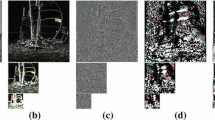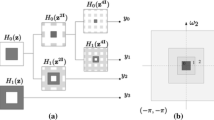Abstract
Color monogenic curvelet transform (CMCT) is a new multi-scale analysis tool for geometric image features. CMCT has useful properties that it behaves at the fine scales like curvelet transform and at the coarse scales like the color monogenic wavelet transform. CMCT has one magnitude and three phases which encode geometric information of color images. In order to demonstrate the properties of CMCT, new color image denoising algorithm is proposed based on CMCT and total variation. The experimental results demonstrate that the proposed algorithm is at par with or exceeds current state-of-the-art algorithms in both visual and quantitative performance.






Similar content being viewed by others
References
Alessandrini M, Bernard O, Basarab A, Liebott H (2013) Multiscale optical flow computation from the monogenic signal. IRBM 34(1):33–37
Amiot C, Girard C, Chanussot J, Pescatore J, Desvignes M (2015) Curvelet based contrast enhancement in fluoroscopic sequences. IEEE Trans Med Imaging 34(1):137–147
Candes EJ, Donoho DL (2005) Continuous curvelet transform: I. Resolution of the wavefront set. Appl Comput Harmonic Anal 19(8):162–197
Candes EJ, Donoho DL (2005) Continuous curvelet transform: II. Discretization and frames. Appl Comput Harmonic Anal 19(2):198–222
Cunha AL, Zhou JP, Do MN (2006) The Nonsubsampled contourlet transform: theory, design, and applications. IEEE Trans Image Process 15(10):3089–3101
Demarcq G, Mascarilla L, Berthier M, Courtellemont P (2011) The color monogenic signal: application to color edge detection and color optical flow. Math Imag Vis 40(3):269–284
Dong GG, Wang N, Kuang GY (2014) Sparse representation of monogenic signal: with application to target recognition in sar images. IEEE Signal Process Lett 21(8):952–956
Do MN, Vetterli M (2006) The contourlet transform:an efficient directional multiresolution image representation. IEEE Trans Image Process 14(12):2091–2106
Easleya G, Labate D, Lim WQ (2008) Sparse directional image representations using the discrete shearlet transform. Appl Comput Harmonic Anal 25(1):25–46
Held S, Storath M, Massopust P, Forster B (2010) Steerable wavelet frames based on the riesz transform. IEEE Trans Image Process 19(3):653–667
Holt KM (2014) Total nuclear variation and jacobian extensions of total variation for vector fields. IEEE Trans Image Process 23(9):3975–3989
Hughes JM, Rockmore DN, Yang W (2013) Bayesian learning of sparse multiscale image representations. IEEE Trans Image Process 22(12):4972–4983
Kim S (2006) PDE-based image restoration: a hybrid model and color image denoising. IEEE Trans Image Process 15(5):1163–1170
Kim SJ, Kang W, Lee E, Paik J (2010) Wavelet-domain color image enhancement using filtered directional bases and frequency-adaptive shrinkage. IEEE Trans Consum Electron 56(2):1063–1070
Lian NX, Zagorodnov V, Tan YP (2005) Color image denoising using wavelets and minimum cut analysis. Signal Process Lett 12(11):741–744
Lim BR, Lee HS, Park RH, Yang SJ (2009) A wavelet packet-based noise reduction algorithm of NTSC images using CVBS characteristics. IEEE Trans Consum Electron 55(4):2407–2415
Lim WQ (2010) The discrete shearlet transform: a new directional transform and compactly supported shearlet frames. IEEE Trans Image Process 19(5):1166–1180
Luisier F, Blu T (2008) SURE-LET multichannel image denoising: interscale orthonormal wavelet thresholding. IEEE Trans Image Process 17(4):482–492
Olhede SC, Ramirez D, Schreier PJ (2014) Detecting directionality in random fields using the monogenic signal. IEEE Trans Inf Theory 60(10):6491–6510
Pennec EL, Mallat S (2005) Sparse geometric image representations with bandelets. IEEE Trans Image Process 14(4):423–438
Pizurica A, Philips W (2006) Estimating the probability of the presence of a signal of interest in multiresolution single and multiband image denoising. IEEE Trans Image Process 15(3):654–665
Selesnick IW, Baraniuk RG, Kingsbury N (2005) The dual-tree complex wavelet transform-A coherent framework for multiscale signal and image processing. IEEE Trans Signal Process 22(6):123–151
Soulard R, Carre P, Maloigne CF (2013) Vector extension of monogenic wavelets for geometric representation of color images. IEEE Trans Image Process 22(3):1070–1083
Veilsavljevic V, Beferull-Lozano B, Vetterli M, Dragotti PL (2006) Directionlets: anisotropic multidirectional representation with separable filtering. IEEE Trans Image Process 15(7):1916–1933
Wen YW, Ng MK, Huang YM (2008) Efficient total variation minimization methods for color image restoration. IEEE Trans Image Process 17(11):2081–2088
Zhang DG (2012) A new approach and system for attentive mobile learning based on seamless migration. Appl Intell 36(1):75–89
Zhang DG, Kang XJ (2012a) A novel image denoising method based on spherical coordinates system. EURASIP J Adv Signal Process 110:1–10
Zhang DG, Zhang XD (2012b) Design and implementation of embedded un-interruptible power supply system (EUPSS) for web-based mobile application. Enterp Inform Syst 6(4):473–489
Zhang DG, Zhu YN (2012c) A new constructing approach for a weighted topology of wireless sensor networks based on local-world theory for the Internet of Things (IOT). Comput Math Appl 64(5):1044–1055
Zhang L, Zhang D, Guo ZH (2010) Monogenic-LBP: A new approach for rotation invariant texture classification. IEEE international conference on image processing, pp 2677–2680
Zhang DG, Li G, Zheng K (2014a) An energy-balanced routing method based on forward-aware factor for Wireless Sensor Network. IEEE Trans Ind Inf 10(1):766–773
Zhang DG, Wang X, Song XD (2014b) A novel approach to mapped correlation of ID for RFID anti-collision. IEEE Trans Serv Comput 7(4):741–748
Zhang DG, Song XD, Wang X (2015a) New agent-based proactive migration method and system for big data environment (BDE). Eng Comput 32(8):2443–2466
Zhang DG, Wang X, Song XD (2015b) New medical image fusion approach with coding based on SCD in wireless sensor network. J Elect Eng Technol 10(6):2384–2392
Zhang DG, Zheng K, Zhang T (2015c) A novel multicast routing method with minimum transmission for WSN of cloud computing service. Soft Comput 19(7):1817–1827
Zhang DG, Liang YP (2013) A kind of novel method of service-aware computing for uncertain mobile applications. Math Comput Model 57(3–4):344–356
Acknowledgments
This work is partially supported by National Natural Science Foundation of China under Grant No. (61563037); Natural Science Foundation of Jiangxi Province under Grant No. (20151BAB207031); Department of Education Science and Technology of Jiangxi Province under Grant No. (GJJ150755).
Author information
Authors and Affiliations
Corresponding author
Ethics declarations
Conflict of interest
The author Shan Gai in this paper declares no conflict of interest.
Additional information
Communicated by V. Loia.
Appendix
Appendix
1.1 Proof of Theorem 1
Let \(f\in L^{2}\left( {\mathfrak {R}^{3},\mathfrak {R}} \right) \), \(M\lambda _{\mu \nu \theta } \left( x \right) =M\lambda _{\mu \nu \theta } \left( {x-\nu } \right) \), and \(\hat{{M}}\) denote the reflection of M, then we have to show
Rights and permissions
About this article
Cite this article
Gai, S. Multichannel image denoising using color monogenic curvelet transform. Soft Comput 22, 635–644 (2018). https://doi.org/10.1007/s00500-016-2361-1
Published:
Issue Date:
DOI: https://doi.org/10.1007/s00500-016-2361-1




